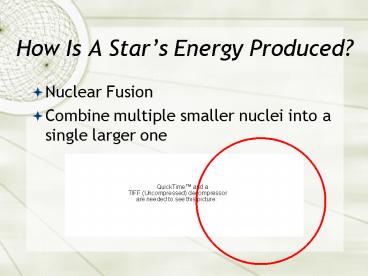How Is A Stars Energy Produced PowerPoint PPT Presentation
1 / 23
Title: How Is A Stars Energy Produced
1
How Is A Stars Energy Produced?
- Nuclear Fusion
- Combine multiple smaller nuclei into a single
larger one
2
How Is A Stars Energy Produced?
- Nuclear Fusion
- Very hot in stars core
- So ions are moving very fast
- If collide strongly enough, can stick together
- Have to overcome repulsion between two positively
charged ions
3
How Is A Stars Energy Produced?
- Must get close enough for nuclear strong force to
overcome repulsion
4
Nuclear Fusion
- In Sun, fuse 4 hydrogen (1 proton each) into 1
Helium (2 protons 2 neutrons)
5
Nuclear Fusion
- Multi-step process proton-proton chain
6
Nuclear Fusion
- In Sun, fuse 4 hydrogen (1 proton each) into 1
Helium (2 protons 2 neutrons) - Why does this produce energy?
- Mass of 1 Helium is about 0.7 LESS than mass of
four protons - Emc2 that tiny mass gets turned into a lot of
energy
7
Nuclear Fusion
- Emc2 that tiny mass gets turned into a lot of
energy - Sun converts about 600 million tons of hydrogen
into 596 million tons of helium every second - 4 million tons (4109 kg) of matter is turned
into energy each second !!! - Still negligible fraction of Suns mass
- (21030 kg )
- QUESTION At this rate, how long would it take
the Sun to use up all of its mass?
8
Getting the Energy Out
- Nuclear fusion only occurs in core
- Need to get the produced energy out
- Most of energy in photons (light)
- Takes a long time to get out due to lots of
interactions - Near core, a photon can only go
- before interacting with other stuff
9
Getting the Energy Out
- So path out in radiation zone is a long zigzag,
called random walk
10
Getting the Energy Out
- Top of radiation zone aboout 2,000,000K
- Photons can be absorbed
- Get convection - blobs of hot gas move
- outward, expand and cool, sink down, repeat
11
Getting the Energy Out
- Convection zone
12
Convection at Suns Surface
Actual movie of convective cells at solar
surface Size of movie area 10000 km on a side
13
General Properties of Stars
- Weve seen one star up close - the Sun
- We observe other stars in our galaxy, and see
them for only a tiny fraction of their lives - a
snapshot - From millions of stellar snapshots, astronomers
figure out how stars work, live and die
14
General Properties of Stars
- Three basic properties determine the life of a
star - 1. Luminosity
- 2. Surface temperature
- 3. Mass
- How do we measure these?
15
Luminosity and Brightness
- Luminosity Total power emitted by star into
space - What are units of power?
16
Luminosity
- Recall Stefan-Boltzmann Law
- Each square meter of a hotter objects surface
emits more light at all wavelengths - J Emitted power per unit surface area
- ? a constant T Temperature
- To get the TOTAL power (luminosity) for a star,
multiply by stars area
17
Luminosity and Brightness
- Brightness How bright a star appears to us
- Depends on stars luminosity and distance from us
- Brightness is the power received from a star per
unit area at the receiver
18
Luminosity and Brightness
19
How does Brightness Change with Distance?
- Follows an inverse square law
- A star twice as far away from us appears 4 times
dimmer - What other physical process follows a similar law?
20
How does Brightness Change with Distance?
- Star emits all of its power into a spherical area
- The same power must go through ever larger
spherical areas as you get further from star - Area of a sphere is.....?
21
Brightness and Distance
- Inverse square law for light
- brightness
22
Brightness and Distance
- Inverse square law for light
23
Brightness and Distance
- Measure the brightness
- IF we know Luminosity, can get distance
- IF we know distance, can get Luminosity

